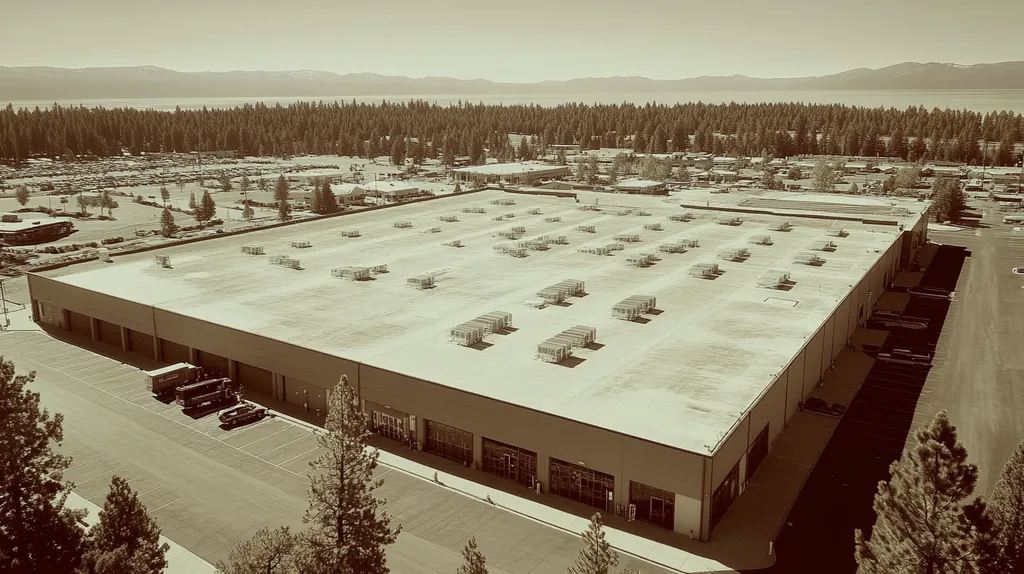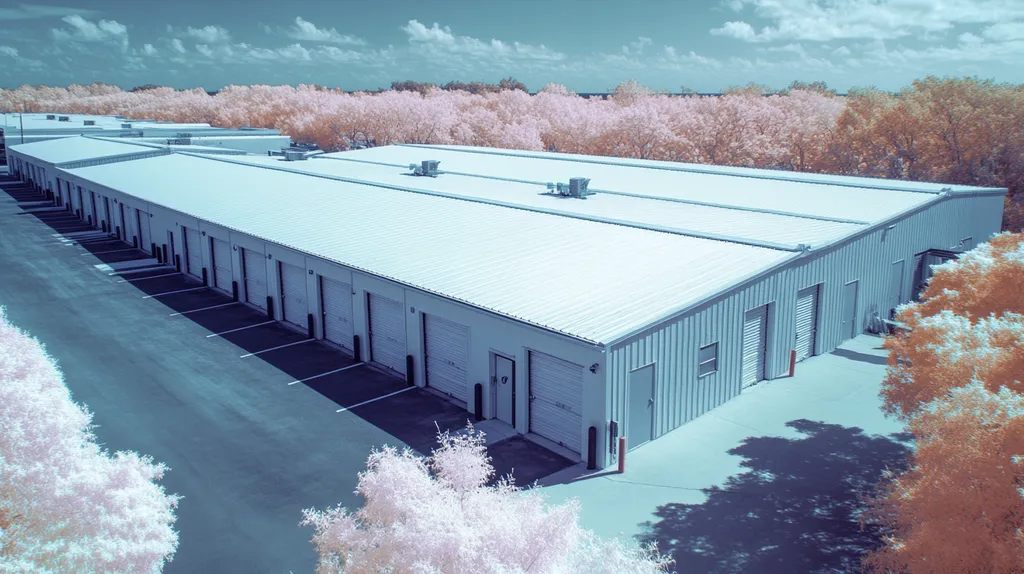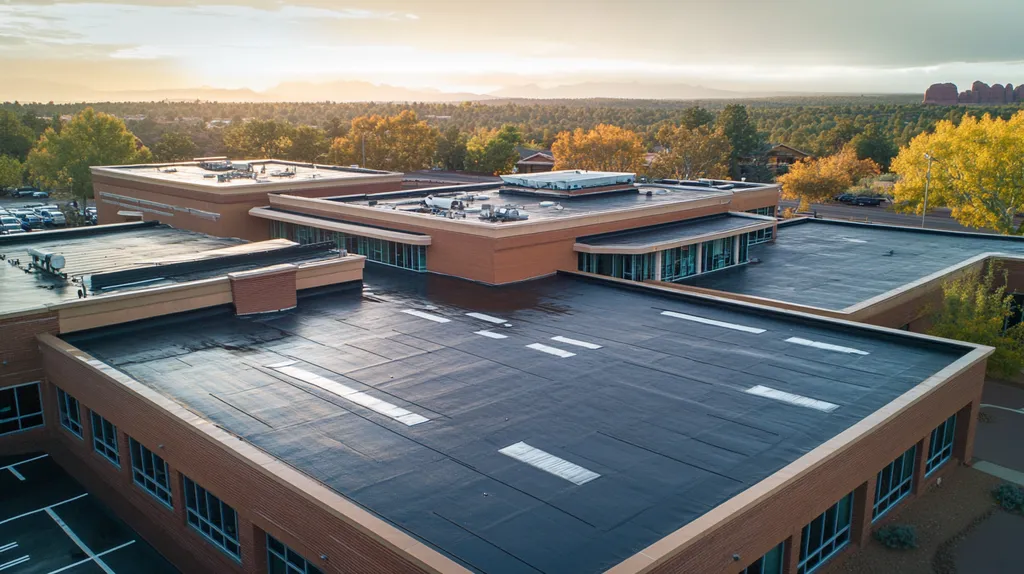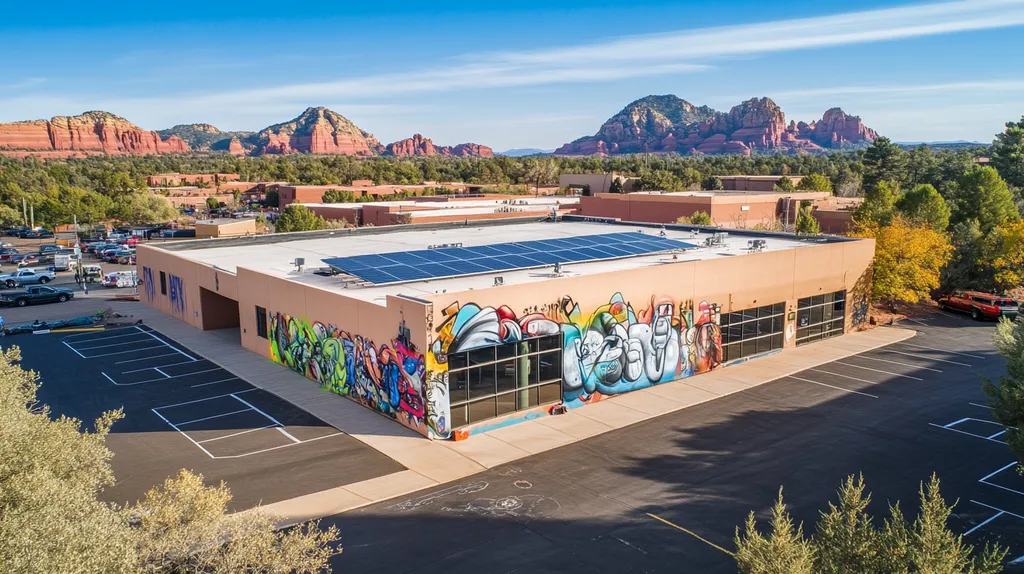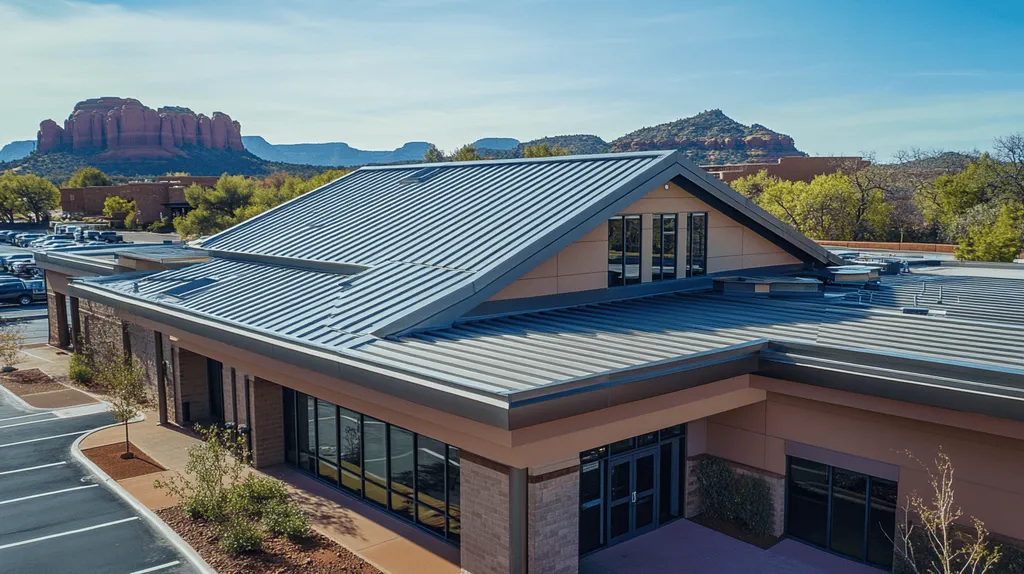Commercial property owners lose millions annually due to inadequate roof coating monitoring, with 40% of premature roof failures linked directly to inspection oversights.
The misconception that coated roofs are “set and forget” systems continues to plague the industry, leading to catastrophic failures and costly emergency repairs.
This comprehensive guide examines the critical importance of ongoing monitoring for coated commercial roofs, revealing evidence-based practices that protect both the building envelope and bottom line.
From dispelling common myths to implementing practical solutions, property owners and facility managers will discover how proper monitoring safeguards their roofing investment while preventing expensive structural damage.
SECTION 1: COMMON MISCONCEPTIONS
Many property owners and facility managers mistakenly believe that once a roofing coating is applied, routine inspections are no longer necessary. This dangerous assumption can result in significant financial losses due to unnoticed damage. In fact, studies reveal that 75% of coated roofs encounter unexpected repairs within the first five years without proper monitoring. It’s crucial to understand the realities of roofing coatings to ensure the longevity and effectiveness of a commercial roof.
Coatings Eliminate Need for Inspections
A common misconception is that applying a coating to a commercial roof removes the necessity for regular inspections. While coatings do enhance a roof’s lifespan, they don’t make it maintenance-free. These protective layers help shield roofs from the elements but aren’t a foolproof barrier against potential issues like leaks or structural weaknesses.
Neglecting regular inspections may result in minor problems evolving into major, expensive repairs. For instance, a tiny crack may not immediately penetrate the coating, but if ignored, it can damage the underlying materials and lead to major leaks.
Consistent inspections are vital to verify the coating’s integrity and performance. Skilled professionals can spot signs of wear that aren’t easy to see. This preventative approach helps sustain the overall health of the roofing system.
Ultimately, dismissing inspections can have serious consequences. A commitment to routine monitoring is essential for extending the life and functionality of any coated roof.
All Coatings Are Created Equal
Another prevalent misconception is that all roofing coatings offer the same level of protection and durability. In reality, coatings can significantly differ in their ingredients, quality, and longevity. Some may be made from subpar materials, which can lead to premature failure.
For example, a high-quality elastomeric coating can provide excellent UV protection, while a lower-grade option might quickly degrade under the same conditions. Property owners unaware of these distinctions risk choosing coatings that don’t meet their specific requirements.
Furthermore, various applications may require distinct types of coatings, tailored to specific environmental conditions. A roof exposed to extreme temperatures or weather needs a coating designed to withstand those challenges. Selecting an unsuitable coating can result in rapid deterioration and expensive repairs.
Understanding the different types of coatings available is key to safeguarding roofing investments. Educating oneself on these variations is crucial for making informed decisions that will affect long-term roof performance.
No Maintenance After Coating Application
Many property owners erroneously assume that a coated roof requires no further upkeep after the application of a coating. This misconception can have dire consequences. Just like any roofing material, coated roofs necessitate regular maintenance and periodic touch-ups.
Environmental influences, including sunlight, rainfall, snow, and debris, can deteriorate coatings over time. A well-maintained coated roof can outlast one that is left neglected. Routine checks for signs of degradation prevent small issues from escalating into significant damage.
For instance, unaddressed ponding water on a coated surface can compromise the coating and create leaks. Scheduled maintenance not only facilitates early detection of issues but also greatly reduces the risks that come with serious roof failures.
Coated roofs require proactive maintenance, countering the idea that they are self-sufficient. Ongoing care ensures that the roof continues to be an effective barrier against environmental challenges, protecting both the building and its occupants.
SECTION 2: PRACTICAL IMPLICATIONS
When it comes to maintaining a coated commercial roof, understanding the practical implications of monitoring is vital. Neglecting regular assessments can lead to severe structural issues that might cut the roof’s lifespan by up to 50%. This section will explore how monitoring impacts roof structural integrity, the significance of proper drainage, and the safety risks posed by various coatings.
Impact on Roof Structural Integrity
The structural integrity of a coated roof is essential for the safety and functionality of the entire building. Regular monitoring helps detect early signs of wear, such as cracks or blisters in the coating. If left unchecked, these seemingly minor issues can lead to major structural problems.
For instance, even a small crack can allow moisture to seep in, promoting rot or compromising the roof’s structure over time. Utilizing monitoring tools like thermal imaging or moisture meters can catch these issues early, preventing costly repairs later on.
Prolonged exposure to UV radiation can further weaken roofing materials. Regular evaluations ensure that coatings effectively block harmful rays, thereby protecting the underlying structure.
Neglecting to monitor these factors can result in increased repair costs and extended downtime. Proactive maintenance is essential for ensuring a safe and dependable environment for all building occupants.
Effects on Drainage and Water Management
Effective drainage is crucial to a coated commercial roof’s performance. Poor drainage can result in water pooling, increasing hydrostatic pressure, which compromises roofing materials and can lead to expensive repairs. Monitoring drainage patterns is essential for identifying potential blockages or malfunctioning drainage systems.
For example, regular inspections can uncover debris buildup in drains that, if ignored, could escalate into significant water damage. Establishing a routine monitoring system around drainage areas can improve efficiency and extend the roof’s lifespan.
Additionally, consistent monitoring allows for better water management strategies. Heavy rainfall or snow accumulation should trigger assessments of drainage efficiency to prevent leaks and damage.
Ultimately, proper oversight of water management practices enhances the roof’s performance and provides a safer environment for building occupants, significantly reducing the risk of water-related issues.
Safety Risks Associated with Coatings
The safety of personnel working on or around the roof must always come first. Certain types of coatings can introduce hazards if not properly monitored, leading to slips, trips, and falls. For example, some reflective coatings become perilously slippery when wet.
Moreover, protective coatings may contain chemicals that require careful handling to avoid health risks. Regular monitoring ensures that the roof remains safe for maintenance staff, mitigating risks from potential chemical exposure.
Ground-level monitoring can also reveal how coatings perform over time, helping to prevent unsafe conditions. Periodic assessments are critical in identifying hazardous situations before they escalate.
A thorough safety plan should incorporate regular monitoring of both the coatings and surrounding areas to reduce risks and protect all individuals involved in roofing operations.
SECTION 3: COST OF MISINFORMATION
The ramifications of misinformation in commercial roofing are significant and often underestimated. A simple misjudgment regarding roof monitoring can result in substantial financial losses. For example, inadequate roof maintenance can lead to repair expenses soaring to over 30% more than those incurred through regular upkeep. Property owners and facility managers must grasp the financial stakes of ignoring accurate information about roof health to avoid costly pitfalls.
Financial Consequences of Neglect
Failing to conduct proper monitoring on a commercial roof brings immediate financial repercussions. Regular monitoring identifies minor issues before they worsen. When small concerns are overlooked, property owners often face unforeseen emergency repairs that could have been prevented.
For instance, a minor leak, if undetected, can lead to serious damage to insulation and structural components. Repair costs can escalate dramatically, often surpassing what would have been spent on routine maintenance. Ignoring critical information from monitoring systems can accumulate significant expenses over time.
Additionally, non-compliance with safety regulations may result in penalties or fines, further compounding financial burdens. By committing to effective monitoring practices, property owners can avoid these pitfalls and promote their financial health.
Increased Repair and Replacement Costs
The impact of inaccurate information can inflate repair and replacement expenses for commercial roofs. When property managers mistakenly assume a roof is in good condition based on misleading monitoring data, significant issues often go unnoticed. These problems may lead to costly repairs or even necessitate a full roof replacement.
Statistics reveal that roofs lacking regular monitoring face a failure rate nearly 80% higher than those that are regularly assessed. An emergency-driven approach to roof maintenance incurs costs that far exceed those associated with ongoing preventive care. In some cases, property owners could end up paying thousands, if not tens of thousands, of dollars unnecessarily.
Moreover, the choice of materials and coatings used significantly affects a roof’s lifespan. Failing to make informed material decisions based on accurate evaluations can further elevate costs. Each lapse in judgment stemming from misinformation can create additional financial strain on a business.
Loss of Business Due to Downtime
Inadequate monitoring can lead to unwanted downtime, causing disruption in business operations. A roof in disrepair can interrupt workflow, resulting in closures or diminished productivity. For example, if water damage occurs due to roofing issues, business activities may come to a halt while repairs are made.
Such downtime not only diminishes immediate revenues but also can harm a business’s reputation. Clients may seek services from competitors during prolonged closures, leading to long-term losses. Effective monitoring of roof conditions is crucial to ensuring that operations run smoothly without interruptions.
In addition, temporary relocations or urgent repairs can be costly, averaging hundreds of dollars per day for facilities unable to operate. Businesses risk damaging their operational efficiency due to avoidable roof failures, impacting their overall profitability.
In summary, neglecting the importance of accurate roof monitoring places property owners at considerable financial risk. Investing in reliable information is vital for protecting business interests and supporting ongoing operational success.
SECTION 4: REALITY CHECK
Neglecting critical pre-coating inspections can trigger costly repairs and disputes that last for years. According to the National Roofing Contractors Association, more than 70% of roofing failures stem from insufficient initial assessments. This highlights the urgency for property owners and facility managers to prioritize thorough evaluations before applying coatings. Key considerations include the significance of core cuts for an accurate roof assessment and the crucial roles of slope and drainage evaluation.
Importance of Pre-Coating Inspections
Pre-coating inspections are essential for maximizing the longevity of coated roofs. These inspections uncover underlying issues that could hinder the new coating’s performance. For example, if water damage or structural weaknesses go unnoticed, the coating may fail prematurely.
By investing in a detailed inspection, property owners can address potential problems before they worsen. A roof with excess moisture may require drying or repairs before applying a coating; overlooking this step could lead to peeling or bubbling, resulting in additional repairs that could have been avoided.
Moreover, pre-coating inspections reveal critical information about existing materials and their compatibility with the new coatings. Different roofing materials react differently to coatings, impacting their overall effectiveness. Ensuring compatibility can greatly extend the roof’s lifespan.
Ultimately, dedicating time and resources to pre-coating inspections builds trust between contractors and property owners, fortifying the integrity of the entire roofing system.
Role of Core Cuts in Roof Evaluation
Core cuts are a vital tool for evaluating roof conditions. This method provides in-depth insights into the layers of the roof system, demonstrating moisture levels and the condition of insulation. Such information is crucial for deciding whether to proceed with coating applications.
For example, finding saturated insulation during a core cut might reveal undisclosed leaks. Addressing such issues before applying a coating is essential to prevent future challenges like insulation degradation and moisture entrapment.
Additionally, core cuts provide information about the thickness and composition of the roofing structure, informing contractors’ choices regarding coating materials and application techniques tailored to specific roof conditions. The right decisions can lead to substantial improvements in roofing performance.
Incorporating core cuts into routine evaluations enhances decision-making, allowing property owners to avoid misunderstandings and protect their investments.
Assessing Roof Slope and Drainage
Effectively assessing roof slope and drainage is crucial for achieving optimal coating performance. Poorly designed drainage systems can lead to water accumulation, jeopardizing both the substrate and the coating. Inadequate slope can result in persistent ponding, increasing the risk of leaks and material degradation.
Understanding the roof’s drainage system facilitates proactive adjustments. If a roof shows signs of inadequate drainage, modifications can be made prior to applying a new coating, such as enhancing drainage channels or installing additional outlets for effective water management.
Furthermore, assessing the slope helps in selecting appropriate coatings designed for specific angles. Different coatings have varying performance levels based on slope, so aligning product choices with actual roof conditions is essential for maximizing effectiveness.
Lastly, implementing a regular evaluation strategy ensures continued performance. Routine checks on drainage and slope post-coating application can prevent water accumulation, safeguarding the investment and maintaining the roof’s health in the long term.
SECTION 5: EVIDENCE-BASED ALTERNATIVES
In the age of coated roofs, having an effective monitoring strategy is essential for maintaining the health of commercial roofing systems. Outdated practices can leave hidden moisture issues undetected, resulting in costly repairs. This section highlights advanced alternatives like infrared scanning, which offers clear advantages over traditional inspection methods. It also underlines the importance of routine sampling and the careful selection of appropriate roofing coatings.
Using Infrared Scanning for Moisture Detection
Infrared scanning presents a cutting-edge solution for identifying moisture lurking beneath roof coatings. Conventional inspections might not detect concealed leaks, allowing damage to escalate unnoticed. This advanced technology leverages thermal imaging to reveal temperature differences that indicate trapped moisture.
This method empowers roofing professionals to target specific areas of concern, significantly reducing unnecessary repairs. For example, facility managers can identify excess moisture buildup beneath an existing membrane, prompting timely maintenance. Utilizing infrared scanning not only minimizes costs but also conserves valuable time through efficient problem-solving.
Additionally, this non-invasive technique protects the roof’s structure while addressing potential issues. As more organizations acknowledge its advantages, infrared scanning is quickly becoming a best practice for assessing roof conditions.
For property owners, implementing infrared scanning leads to greater roof durability and a lower incidence of costly leaks. Thus, it should be an integral element of any thorough roofing maintenance plan.
Benefits of Routine Visual and Core Sampling
Integrating routine visual inspections with core sampling creates a comprehensive strategy for monitoring roof conditions. While visual checks are crucial, they can overlook underlying problems, making core sampling a necessary supplement for thorough evaluations. Core sampling involves extracting a small section of roofing material for direct condition analysis.
Together, these methods paint a clearer picture of both surface and subsurface conditions. Routine visual assessments can highlight areas needing attention, while core sampling uncovers the health of the underlying materials. For instance, detecting moisture within insulation layers enables prompt repairs before larger, costlier issues develop.
Establishing structured routines for both visual inspections and core samples allows facility managers to make maintenance decisions based on solid evidence rather than assumptions. This proactive approach not only extends the lifespan of the roof but also minimizes total ownership costs.
Ultimately, a systematic strategy ensures that repairs and maintenance decisions are grounded in real-time data, fostering informed management of roofing assets.
Selecting the Right Coating for Your Roof
The selection of roof coating plays a pivotal role in the functionality and longevity of a commercial roof. Many property owners underestimate the long-term advantages of choosing the material that best suits their specific environment. For example, reflective coatings help reduce heat absorption, thereby lowering energy costs and enhancing the roof’s lifespan.
Various coating formulations exist, each tailored for different climates and building types. Factors like UV exposure, moisture levels, and local weather patterns must be considered during selection. This strategic approach significantly bolsters the roof’s resistance to environmental stressors.
Furthermore, the right coating often improves warranty coverage, providing additional protection against unforeseen issues. When facility managers opt for high-quality coatings, they invest in the long-term stability of the building.
In summary, making deliberate choices about roof coatings not only boosts efficiency and durability but also saves property owners substantial resources over the roof’s lifespan. This proactive material selection aligns seamlessly with the growing trend towards sustainable building practices.
SECTION 6: TEST AND VERIFY
Testing and verification are vital processes for maintaining the health of a coated commercial roof. Neglecting these crucial steps can lead to costly failures and decreased roof performance. Studies indicate that roofs that undergo regular testing are significantly less likely to experience early failures, underscoring the importance of proactive maintenance. Through strategic inspections, established safety protocols, and diligent documentation, property owners can protect their investment and ensure the roof serves its purpose effectively.
Conducting Thorough Roof Inspections
Regular inspections are essential for spotting potential issues before they escalate into major problems. Property owners should aim for at least two inspections each year, with additional checks following severe weather events. Inspectors need to identify signs of wear such as cracks, blisters, or debris, which can all compromise the roof’s integrity.
Incorporating advanced technology, like infrared thermography, can greatly enhance the accuracy of these inspections. This method helps detect moisture trapped beneath the roof coating, enabling targeted and effective repairs. Additionally, thorough evaluations of drainage systems during inspections can prevent water pooling, a common cause of premature coating failure.
Proper documentation of inspection findings is equally important. Keeping detailed records allows facility managers to track the roof’s condition over time and identify patterns that may require attention. This thorough documentation not only aids in planning for maintenance but also serves as crucial evidence for warranty claims when necessary. Prioritizing these evaluations can significantly extend the roof’s lifespan.
Implementing Safety Protocols During Coating
Maintaining safety during the coating application process is crucial, as it protects both workers and the roof’s integrity. Coating application may involve handling hazardous materials, which is why robust safety protocols must be established prior to any work commencing.
Having a trained safety officer on-site can help minimize incidents. Their role includes ensuring that all workers don appropriate personal protective equipment (PPE) and follow established safety procedures. Safety training sessions can also be beneficial, educating the team on best practices and emergency response protocols.
Moreover, it is essential to assess weather conditions before starting the coating application. Factors like rain, wind, and extreme temperatures can adversely impact the coating’s adhesion. By staying vigilant about safety, property owners can protect their workers and avoid costly application mistakes that could compromise the roof’s performance.
Documenting and Analyzing Inspection Findings
Documenting inspection findings goes beyond mere record-keeping; it is a cornerstone of effective roof management. Detailed records help facility managers track trends and recurring problems that may necessitate larger system improvements. Consistent documentation is vital for forecasting maintenance needs and budgeting accordingly.
Analyzing this data can also indicate whether a roof needs a full replacement rather than just repairs. By reviewing historical data, property owners can make informed decisions regarding their roofing systems. Furthermore, maintaining thorough records strengthens warranty claims by providing proof of regular maintenance.
Utilizing a centralized digital platform for storing and analyzing these findings enhances overall efficiency. Dashboards can synthesize critical metrics, making it easier for property owners to make informed, data-driven decisions. Ultimately, comprehensive documentation and analysis form the backbone of a solid maintenance strategy, securing the roofing investment for years to come.
The Bottom Line
With 40% of premature roof failures directly linked to inadequate monitoring, the stakes for proper coating oversight couldn’t be higher.
The evidence clearly shows that regular inspections, including infrared scanning and core sampling, can extend a roof’s lifespan by up to 50% while preventing catastrophic failures.
Property owners who implement comprehensive monitoring programs typically save 30-40% on long-term maintenance costs compared to those relying on reactive maintenance.
Moving forward, facility managers must prioritize proper pre-coating inspections, ongoing monitoring protocols, and detailed documentation to protect their roofing investments.
The future of commercial roofing depends on replacing outdated “set and forget” mindsets with evidence-based monitoring strategies that safeguard both building integrity and bottom lines.
FREQUENTLY ASKED QUESTIONS
Q. Do coated commercial roofs need regular inspections?
A. Yes, regular inspections are essential to identify potential issues early. Coatings enhance roof longevity, but they don’t eliminate the need for monitoring. Over time, small problems can develop into significant repairs if not caught early.
Q. How does monitoring impact the structural integrity of an industrial roof?
A. Monitoring is critical for maintaining structural integrity. Regular assessments help identify wear or damage that could compromise the roof. This proactive approach prevents minor issues from escalating into costly structural problems, ensuring safety.
Q. What are the financial consequences of neglecting roof monitoring?
A. Neglecting roof monitoring can lead to substantial financial losses. Without regular checks, minor issues may escalate, resulting in emergency repairs that cost significantly more. Inaccurate assessments can also inflate operational expenses.
Q. Why are pre-coating inspections important for a commercial roof?
A. Pre-coating inspections are vital to identify underlying issues that may affect coating performance. They help ensure there are no hidden problems that could lead to premature failure, safeguarding your investment in the roof.
Q. How does infrared scanning help in monitoring a commercial roof?
A. Infrared scanning is a powerful tool for detecting moisture beneath roof coatings. It identifies temperature variations that signal hidden leaks, allowing for targeted repairs. This technology helps prevent extensive damage and associated costs.
Q. What safety protocols should be in place during roof coating application?
A. Safety protocols are essential to protect workers and ensure coating integrity. Proper PPE must be worn, and weather conditions assessed prior to application. Training staff on safety procedures minimizes risks during the process.
Q. What is the benefit of documenting inspection findings for a commercial roof?
A. Documenting inspection findings is crucial for effective roof management. It helps track trends, inform maintenance decisions, and strengthen warranty claims. Keeping detailed records supports proactive management and helps avoid unexpected failures.

